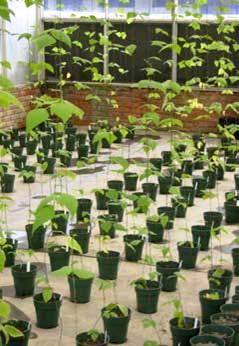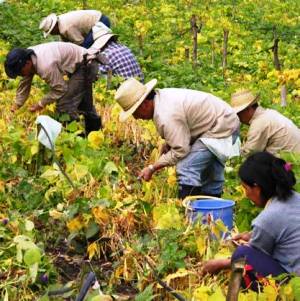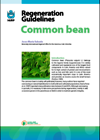Regeneration guidelines for bean
|
View regeneration guidelines in full (in PDF)
Also available in the following languages: |
The information on this page was extracted from:
Salcedo J.M. 2008. Regeneration guidelines: common bean. In: Dulloo M.E., Thormann I., Jorge M.A. and Hanson J., editors. Crop specific regeneration guidelines [CD-ROM]. CGIAR System-wide Genetic Resource Programme, Rome, Italy. 9 pp.
Before reading the regeneration details for this crop, read the general introduction that gives general guidelines to follow by clicking here.
Introduction
Common bean (Phaseolus vulgaris L.) belongs to the legume family (Leguminosae). It is widely cultivated and represents one of the largest food components in Latin America and Africa valued for its high content of protein and micronutrients such as iron and folic acid. It is one of the most economically important crops in Latin America and provides an income source for small farmers (Pachico 1989).
The common bean is mainly self-pollinated; however, many authors have reported outcrossing or natural hybridization in both wild and cultivated populations. Ibarra-Perez et al. (1997) reported cross-pollination rates between 0 and 85%.
 Common bean (Phaseolus vulgaris L.) growing the greenhouse. (photo: Orlando Toro/CIAT) |
Although outcrossing is sporadic, it is necessary to take some precautions during regeneration, mainly in wild accessions grown in the greenhouse or field in order to maintain genetic integrity.
Choice of environment and planting season
Climatic conditions
- Common bean grows well at temperatures ranging from 15 to 27°C and will withstand temperatures up to 29.5°C.
- High temperature (close to or higher than 35°C) and moisture stress during flower and pod setting results in abortion of large numbers of blossoms and developing pods.
- The ideal growing conditions are rainfall of 350–500 mm rainfall during the growing season combined with low relative humidity to minimise risk of bacterial and fungal disease.
Planting season
- Beans are considered a warm-season crop, sensitive to temperature extremes. Low temperatures slow down plant growth while high temperatures accelerate it. Generally, plants are more adaptive during short days; they are very frost tender and need a minimum average soil temperature (18°C) to germinate well. Sow after the last frost-free date. Take account of day length and temperature when selecting time of sowing to ensure the most favourable growing conditions.
- Most types of bean require a frost-free growing season of 85 to 120 days.
Preparation for regeneration
 Regenerating common bean (Phaseolus vulgaris L.)in the greenhouse at CIAT, Palmira,Colombia.(photo: Orlando Toro/CIAT) |
When to regenerate
- When seed stocks are <1200 seeds.
- When germination drops below 85% during the initial germination test before storing or the periodical monitoring of viability every 5 years.
- If the seed stocks are found to be infected by pathogens, i.e. fungi, bacteria and viruses.
Field selection and preparation
- In general, common bean requires deep, fertile soil, from loose to slightly compact, with good physical properties, a pH of 5.5–6.5, and flat or rolling topography with good drainage.
- Prepare the seedbed carefully then irrigate before planting so that the soil is uniformly moist.
- The altitude of the planting area should be the same as, or very similar to, the altitude of the origin of each material to ensure flowering.
To avoid disease problems, do not grow beans in the same field in consecutive years.
Greenhouse regeneration (see photo)
- Use 8 litre poly pots (recommended size) as seedbeds to allow sufficient space for root development.
- If re-using pots, remove any dirt with a brush, wash pots thoroughly in disinfectant, rinse and soak in a 5% bleach solution for 5 minutes, drain and stack to dry.
- Fill pots with sterile soil or soil replacement and tamp gently to settle soil.
- Water the soil gently to ensure it is damp throughout and settled into the pot; the level needs to be about 3–5 cm below the rim to ensure water does not run out.
Method of regeneration
To maintain genetic integrity, collect seed sample from the original source if possible. The minimum quantity of seeds required for regeneration is 80. In some cases, especially accessions from germplasm donations, the minimum number of seeds is not always available, but regeneration should still be carried out.
One of the few outcrossing species is Phaseolus coccineus L., which is a virtually obligate ‘outcrosser’. To obtain adequate seed and maintain diversity, plants should be sib-pollinated (in some cases, particularly with the cultivated varieties, tripping will work to get adequate seed, but may not give good diversity).
 Field plots of common bean (Phaseolus vulgaris L.) at CIAT, Tenerife, Colombia. (photo: Orlando Toro/CIAT) |
Planting layout, density and distance
- Plant bean seeds in rows 2–5 m long. Plots of 3–5 rows may be adequate, depending on the number of seeds being planted per accession (see photo).
- Bush-type dry bean varieties are best planted in 40-cm rows, or drilled in narrow rows, which allows them to fill in rows more quickly and shade out weeds.
- Space plants 20–30 cm apart, with up to three seeds per hole.
- Plant at a depth of 3–5 cm.
- In the greenhouse, plant the seed at a depth of 2–3 cm. Use three seeds per pot and thin to two plants after germination. Use 25 pots (50 plants) for each accession to assure genetic diversity.
Planting method
In the field:
- In order to avoid mechanical damage to the seeds, plant by hand.
- Use a bamboo pole, or similar, for accessions with an indeterminate growth habit (climbers).
- For accessions with semi-climber or prostrate growth habit, cut the vines when they are too vigorous to avoid connection between accessions.
In the greenhouse:
- Place seed on top of soil and press with a finger to push it into the soil or use a ‘dibble’ to make a hole for the seed.
- After planting, gently water the soil to moisten it and dampen the seed.
Crop management
Fertilization
- Common bean responds well to both chemical and organic fertilizer. Do a soil test to determine soil fertility status.
- Apply fertilizer at the time of sowing.
- In general, organic materials are recommended as they increase the population of saprophyte micro-organisms and help to reduce the presence of disease in the crop.
Weed management
- Keep the seedbed weed free to allow seedlings to establish. The most critical time is between 15–30 days after emergence of seedlings.
- Weed by hand if labour is not a constraint or use recommended herbicides, especially pre-emergence formulations.
- Up to three weedings may be required in the case of hand or mechanical weeding before the crop canopy fully covers the ground.
- After flowering, avoid weeding, or keep to a minimum, as it tends to result in flower loss.
Thinning
- Thin 2 weeks after seedling emergence or at four-leaf stage, leaving one seedling per station. This should be done when the soil is moist and soft to make hand-pulling easy.
- Take care not to break shoots or damage the root system of remaining seedlings. Thin during the cooler part of the day (early morning or late afternoon) to reduce stress on plants.
Irrigation
- If regeneration is carried out under rainfed conditions, provide supplementary irrigation during drought periods. Where a sprinkler system is used, avoid overwatering during flowering to lessen flower drop.
- Use furrows for flood irrigation and water once a week for 2 hours, more often during flowering.
Common pests and diseases
Contact plant health experts to identify pest and disease symptoms and appropriate control measures. Common pests and diseases include:
- Beet armyworm, stem maggot, white grub, aphid, leaf drillers, pod-sucking bugs, stem borers, thrips and weevils
- Greenhouse pests: whitefly (Tialeurodes vaporariorum), thrips such as the western flower thrip (Frankliniella occidentalis) and two-spotted spider mite (Tetranychus urticae)
- Anthracnose (caused by the seed-borne fungus Colletotrichum lindemuthianum)
- Angular leaf spot, scab and Ascochyta blight
- Rust (caused by the fungus Uromyces phaseoli)
- Bacterial blights (caused by e.g. Xanthomonas phaseoli, Pseudomonas phaseolicola, Xanthomonas fuscans and Corynebacterium flaccumfaciens)
- Bean common mosaic virus BCMV (caused by mosaic viruses spread by aphids)
Pest and disease control
- Plant beans after a cereal crop such as maize, wheat or sorghum, rather than after soya beans or sunflowers to avoid disease problems.
- Check fields and greenhouses weekly for insect pests.
- In the greenhouse, avoid disease by not over-watering plants and ensure that soil or growing medium is properly sterile before planting. Increasing humidity (e.g. with a misting system) encourages beneficial insect predators and discourages insect pests such as mites.
 Harvesting common bean (Phaseolus vulgaris L.) in the field at CIAT, Tenerife, Colombia. (photo: Orlando Toro/CIAT) |
Harvesting
- Harvest when pods become dry, before shattering. Dryness can be judged by the rattling sound pods make when shaken and by brown pod colour. Harvest immediately to avoid pest damage.
- Harvest one accession (plot) at a time by hand picking the mature pods from each plant (see photo) and placing them in paper bags or other appropriate containers, which are labelled both outside and inside.
- Keep the bags of each accession together inside a labelled muslin cloth bag for drying.
Post-harvest management
1. Where ambient conditions are not conducive to pre-drying, use cold air-flow cabinets at 20°C and 35% relative humidity. (These can be improvised by using regular fans to create a continuous airflow.)
2. Extract seed from dried pods manually to avoid damage to the seed embryo. This may involve opening the pods individually by hand or tapping the muslin cloth bag containing pods with a small rod.
3. Clean by removing damaged or immature seeds and discarding foreign plant material.
This could be done by winnowing with baskets.
4. Verify the identity of each accession by comparing seeds with the original sample and with photographic images of seeds that were sown. (See section below.)
5. Visually check the entire lot of seeds harvested per accession and count out at least 1220 seeds, which is the minimum number required for storage per accession.
6. Dry seeds for a second time in hermetically sealed storage rooms at 20°C and 20% relative
humidity. The seeds reach moisture levels close to 9%.
7. Carry out seed tests for viability (50 seeds) and health (200 seeds).
8. Pack seeds in plastic containers with airtight closure at 5°C while awaiting results from the viability and health tests.
9. Verification of viability higher than 85%.
10. Verification of healthy sample free of fungi, bacteria and viruses.
11. Third seed drying in hermetically sealed storage rooms at 15°C and 10% relative humidity, where seeds reach moisture levels close to 6%. Alternatively, reduce seed moisture content using silica gel at 2:1 or 3:1 ratio in closed cabinets (or desiccation jars for small volumes).
12. Verify moisture of each accession in micro ovens using 1 g ground seed per accession. Moisture content may also be determined by non-destructive methods using electronic moisture meters.
13. Vacuum-pack seed in aluminium foil packets identified with barcode and accession number, taking samples for separate purposes: 1.) Distribution, 2.) Base collection, 3.) Periodic monitoring, 4.) Safety duplicate, 5.) Return to country of origin.
Monitoring accession identity
Compare with previous passport or morphological data and compare the following characterization traits, using data from seed characterization according to standard descriptors for common bean seeds (IBPGR 1982).
In seedlings and mature plants:
- Type of germination (hypogeal/epigeal)
- Hypocotyl colour
- Growth habit
- Days before flowering
- Flower colour
- Type of pods
- Height
In seeds:
- Main colour
- Secondary colour
- Tertiary colour
- Seed shape
- Weight of 100 seeds
- Seed brightness/opacity
Regeneration of wild common bean
Wild populations of common bean generally have smaller seeds which in some cases still have significant dormancy levels or require more specific conditions for germination. Before sowing, treat seeds with pre-germination processes in laboratory conditions.
- Disinfect seeds following a standard protocol: 1) soak in 70% alcohol for 1 min, 2) in fungicide for 10 min, 3) 2.5% sodium hypochlorite for 5 min.
- Spread seeds out onto germination paper or filter paper in petri dishes, at 30°C with 8 hours light–16 hours darkness, in germination cabinets or under laboratory conditions.
- After the radicle and apical meristem have emerged, transfer seedlings to plastic pots with sterile, lightly fertilized soil.
- Use closed greenhouses to avoid the risk of outcrossing.
- Space pots 20–30 cm apart.
- Depending on the material growth habits, some conditions need to be provided to facilitate a good development (use of guide strings for climbing plants for instance, sufficient spacing between prostrate plants, and 80 cm wooden sticks for bush plants)
- Some wild materials still feature early pod dehiscence. When fruits start to mature, perform daily monitoring to harvest the seeds before pods open, thus preventing seed loss.
- Carry out post-harvest management in the same way as for cultivated materials.
Documentation of information during regeneration
Collect the following information during regeneration:
- Regeneration site name and map/GPS reference
- Name of collaborator
- Field/plot/nursery/greenhouse reference
- Accession number; population identification
- Generation or previous multiplication or regeneration (if generation is not known)
- Preparation of planting materials (pre-treatments)
- Sowing date and density
- Field layout used
- Field management details (watering, fertilizer, weeding, pest and disease control, stresses recorded, others)
- Environmental conditions (altitude, precipitation, soil type, others)
- Emergence in the field or greenhouse (number of plants germinated)
- Number of plants established
- Days from sowing to flowering
- Breeding system
- Pollination control method used (method, number of plants pollinated)
- Harvest date and method
- Number of plants harvested
- Quantity of seeds harvested
- Agronomic evaluation; agro-morphological traits recorded
- Comparisons with reference materials (record any identification numbers or references of any samples taken from this regeneration plot)
- Post harvest (describe any relevant procedures)
References and further reading
Bioversity International, CIAT. 2009. Key access and utilization descriptors for bean genetic resources. Bioversity International, Rome, Italy; International Center for Tropical Agriculture, Cali, Colombia. Available here.
Ibarra-Perez FJ, Bahman E, Saines G. 1997. Estimation of outcrossing rate in common bean. Crop Science 37:60–65.
IBPGR. 1982. Phaseolus vulgaris Descriptors. IBPGR, Rome, Italy. Available here.
Lewis G, Schrie B, Mackinder B, Lock M, editors. 2005. Legumes of the World. Royal Botanic Garden Publishing, Kew, UK. 592 pp.
McCormack J. 2004. Bean Seed Production. An organic seed production manual for seed growers in the Mid-Atlantic and Southern U.S. Available for purchase from: http://www.savingourseeds.org.
Pachico D. 1989. Trends in world common bean production. In: Schwartz HF, Pastor-Corrales MA, editors. Bean production problems in the tropics. CIAT, Cali, Colombia. pp. 1–8.
Rios M, Quirós J, Arias J, editors. 2003. Fríjol. Recomendaciones generales para su siembra y manejo. Antioquia, Colombia. Corporación Colombiana de Investigación Agropecuaria Corpoica.
Salcedo J, Debouck DG, Torres AM, Guevra C. 2006. Flow chart of operations for bean and tropical forage germplasm. Genetic Resources Unit files (Poster). CIAT, Cali, Colombia.
Available from: http://isa.ciat.cgiar.org/urg/showunitfiles.do?type=unitfiles&by=&collection. Date accessed: 30 September 2008.
Welsh MM. 2008. Operations Manual for the Phaseolus Germplasm Collection. Western Regional Plant Introduction Station, Pullman, Washington.
Acknowledgements
These guidelines have been peer reviewed by Molly Welsh, USDA Western Regional Plant Introduction Station, USA; and Jaime Roberto Fonseca and Tereza Cristina de Oliveira Borba, Empresa Brasileira de Pesquisa Agropecuária (EMBRAPA), Brazil.
Comments
- No comments found






Leave your comments
Post comment as a guest